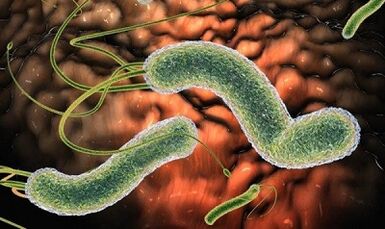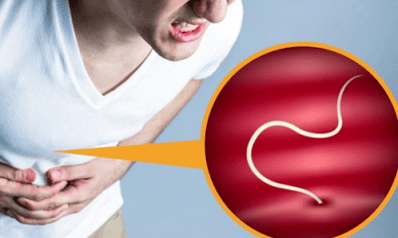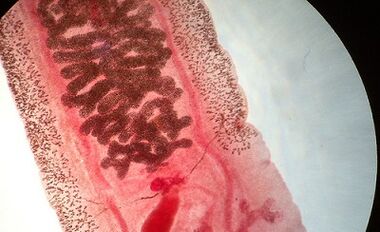
Among the patients, a serious misunderstanding is that the helminths live only in the intestine.However, it cannot be denied that parasites in human blood are widely wide like other types of elmintie.The identification and timely therapy of these pathological states require particular attention, since when it enters the bloodstream, a small grip can affect absolutely any organ.
Symptoms and painful sensations that cause worms in the blood in man can be different both in the manifestations and in the degree of their gravity.It is important to start treatment in a timely manner and prevent the further spread of parasites on the human body in order to prevent complex consequences in a timely manner.Initially, it is necessary to find out how the worms appear in the blood.
Types of parasites that set the blood flow
Nothing is very complicated by the production of the correct differential diagnosis as a great diffusion of the symptoms that occur in patients with parasites in the blood.Various types of helminths cause different signs.In case of infection from worms with blood or blood vessels, the patient must undergo a complete medical examination that will help identify the type of parasite and determine the adequate treatment of the pathological condition.
There are a number of parasites that are able to live in human blood:
- Babesia;
- Malaria Plasmodium;
- Tripanosome;
- ankilostoma;
- Trichinella;
- Toxoplasma;
- Toksikara.
Most of the helmets enter the human body after a insect bite.These parasites of the circulatory canal are very dangerous for children.They affect the correct development of the organs, the growth of the entire body and the state of the immune system.Many people can live with parasites for years and do not even suspect they are infected.
General symptoms of parasitic blood poisoning
Every single type of parasites in human blood has symptoms that are characteristic only for this disease.
However, there are a series of characteristic signs of any type of elmintosis:
- weakness;
- dizziness, headache;
- nausea, vomiting;
- Total body temperature can be increased;
- It hurts the limbs and the whole body;
- Attacks of loss of consciousness are possible.
All these symptoms are the main manifestations of the increase in the content of toxic substances in the body.At the beginning their appearance, it is necessary to contact a medical institution in which the doctors will carry out all the necessary diagnostic tests and procedures, which will accurately determine the cause of this state.
Babesosis: symptoms, diagnosis and treatment
Babesia are small parasites that enter the human body after a bite of a check sign IXODIC.These simpler organisms quickly penetrate the erythrocyte membrane inside and begin their difficult life cycle.The disease is widely used in the hot regions where the mites of the IXODES clan live.
In most cases, the disease proceeds without evident symptoms in both adults and children.
However, when the disease appears and is further developed, the characteristics are observed:
- hemolytic anemia;
- fever at 39-40 degrees;
- chills;
- increase in sweating.
Similar symptoms appear no later than 4 weeks after the bite of the check mark.After the incubation period, the chances of identifying the disease are much higher.
The disease can be diagnosed only in the conditions of specialized workshops.For this reason, there are not so many data on the dissemination of the disease and its symptoms.
However, the attending physician should adopt a series of measures to identify pathogens aliens in the patient's body:
- General blood examination;
- Serological tests for women antibodies;
- Polyimerase chain reaction;
- Microscopic examination of the blood press (Hymse coloring).
The treatment is mainly carried out with anti -proteozoa drugs.In general, the course of taking these funds does not last more than 10 days, but can continue in patients with a recurring form of illness.The treatment of asymptomatic patients is carried out only when the causal agent of the babysseosis is detected in the blood during the -analysis, which is carried out a few months after the initial detection, when the frequency disease was recurring.
Tripanosomosis: symptoms, diagnosis, treatment

Tripanosomosis, about an sleepy disease called, is widespread in the countries of the tropical and subtropical climate and is rarely found in temperate latitudes.The causal agent of the disease is a tripanosome.This is a small parasite.Having looked at the photo of the parasite made with an electronic microscope, it is possible to distinguish the scourge and a membrane along the entire length of the simplest body.
The disease and its symptoms develop in two complete phases.In the first phase, the parasite penetrates human red blood cells and begins its active reproduction.
This phase can be recognized by the following signs:
- fever attacks up to 7 days;
- headache, weakness;
- joint pain and arts;
- Severe itching;
- The appearance of Chack Rossi on the site of inflamed lymph nodes.
In the second phase of the disease, tripanosome penetrates the central nervous system through the blood barrier.This phase is characterized by serious sleep and vigil cycle: the main symptom of the disease.
Furthermore, in the patient in the second phase of the sleepy disease it may appear:
- blurred consciousness;
- Muscle tremature, weakness;
- paralyzed arts;
- apathy;
- irritability;
- Aggression in relation to others.
It is necessary to start treatment as soon as possible, otherwise it is not the most favorable result.Progression, the disease leads to the appearance of organ insufficiency of different body systems at the same time, whose consequence is the patient's death.
The diagnosis of sleepy disease is based on the symptoms of patients and microbiological studies due to the presence of triple in the blood, lymph and purulent fluid taken from Shancra.With positive samples, the treatment is urgently prescribed.
A good prognosis can be done when the disease can be detected in the hemolytic phase.At this moment, quite toxic drugs are prescribed, but in general the treatment is well tolerated by the patient's body.
However, when the disease manages to recognize only in the second phase, the prognosis is not always comforting.To treat such a pathological condition, it is necessary to use serious and toxic drugs that can penetrate through the protective barrier of the central nervous system.
Malaria: symptoms and treatment

The malaria plasmodium infection occurs through a mosquito bite.Through the salivary glands of the females, the parasite penetrates the bloodstream of a person, is transferred with a blood flow in the liver, where the first stages of metamorphosis pass, and then enters the bloodstream again and hits the red blood cells.
The incubation period of the disease lasts up to 25 days.So the first symptoms of malaria are manifested:
- a strong increase in body temperature;
- headache, weakness;
- hemolytic anemia;
- Skin of the skin;
- nausea, vomiting;
- joint pain, pain throughout the body;
- attacks of convulsions;
- The emergence of products of the destruction of red blood cells in the urine.
Basically, the disease is widespread in the warm and warm regions, therefore its diagnosis is based only on the symptoms and history of the patient's life that manifests itself over time.Frequent travel to equatorial countries can cause the development of the disease.In addition, standard blood tests and a microbiological examination of body fluids are performed.
Therapy is prescribed depending on the type of disease and its severity and is performed mainly using antimalaric drugs.
ANCHILOSTOMOSIS: Symptoms, diagnosis and treatment
The parasites that cause the disease live in the genes of the header and feed on the blood of the master's blood.The worms penetrate through the skin of a person and begin migration in the intestine.In the process of moving around the body, the parasites with the blood flow fall into the lungs, then pass along the bronchi in the trachea and in the upper respiratory tract, where they cause a reflection of swallowing, and therefore reach the intestine, on whose walls they are fixed.
In rare cases, the worms of worms are unable to successfully complete their migration and remain under the skin of a person.In the photo, a similar process recalls small and thin snakes under the patient's skin.

Eating blood, worms cause the development of iron deficiency anemia in an infected person.The most dangerous when worms penetrate the body of children.The lack of iron, proteins and other components necessary for the development of a child can cause mental retardation, growth delay and physical inferiority.
The main symptoms of anchilostomosis:
- iron deficiency anemia;
- Fever attacks;
- pain in the abdomen;
- nausea, vomiting;
- diarrhea, constipation;
- severe body weight loss;
- Cough and infectious diseases of the upper respiratory tract are possible during the migration of the parasitic larvae phases.
Among the diagnostic measures, an examination of general blood, the analysis of the stool and urine, there are an ultrasound examination of the digestive system.The identification of parasites becomes a good reason to start the immediate treatment and the prevention of the pathological conditions associated with the compromised functioning of the respiratory, digestive and circulatory systems of the patient's body.
The treatment is carried out by an intake of the antielmintic drug.The therapy is integrated with the use of vitamin and mineral complexes, allowing you to smooth out the consequences of the deficiency of hemoglobin.
Toxocarosis: symptoms and treatment
The causal agents of this disease are round eliminates, which a person can obtain after prolonged communication with pets who have not passed the deworming, when they eat unreal vegetables and fruits.The human body becomes an intermediate guest of the parasite.
Entering the intestine, the larvae hatch the eggs and begin to "pierce" the intestinal wall, penetrating the bloodstream.With the blood flow, the helminths migrate to any system of the human body.The result of the migration of worms is a serious liver liver, the heart, the central nervous system and the organs of vision.

The main symptoms of body toxocracoli infection:
- increase total body temperature;
- the appearance of severe pain in the abdomen;
- weakness, dizziness;
- the appearance of an allergic eruption on the skin;
- Forty cough at night;
- Convulsions, muscles and joint pain.
The diagnosis of the disease is quite difficult.It is necessary to conduct serious microbiological and allergological tests for which a specialized laboratory is required:
- Polyimerase chain reaction;
- immunosorbent analysis;
- Serological tests;
- ultrasound examination of the organs;
- Magnetic resonance imaging and computerized tomography.
Serilmintic therapy severe is carried out only when serious damage to the brain is detected, the patient's heart muscle.Very often the disease passes independently, since the larval stadium cannot develop in an adult individual in the body of an intermediate guest.
However, it is necessary to take into account the damage that migratory worms can cause the patient.It is necessary to perform a support therapy and take the necessary measures to prevent the development of serious pathological processes in the liver, cardiovascular and other organs.
Conclusion
Any parasites are dangerous for the human body.If questions arise: "What parasites live or use blood as a transport system", "how to determine it correctly or not", "how to treat them and what to take", then it is better to contact a parasitologist and not make independent decisions.The treatment and prevention of parasitic diseases are a decision that a qualified doctor should make.




























